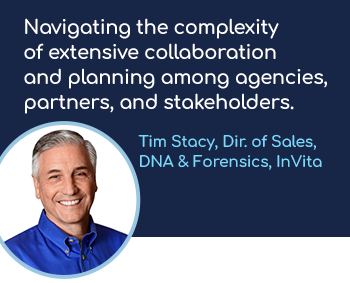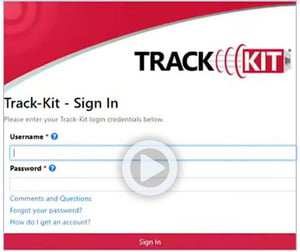
InVita's own Sexual Assault Kit tracking system expert, Tim Stacy, joined us for an exclusive interview. From Tim's early days as a DNA analyst to his current position at InVita Healthcare Technologies, home to Track-Kit™ and STACS® products, Tim's expertise includes everything from when the first grant was issued to the present day.
Collaboration between stakeholders across legislative, procurement, implementation, and support is essential to ensure a successful rollout of a statewide Sexual Assault Kit tracking system. Having decades of experience, Tim is here to guide us through this process.

 What was the catalyst for the Sexual Assault Kit tracking initiative (SAKI) and how far has it progressed?
What was the catalyst for the Sexual Assault Kit tracking initiative (SAKI) and how far has it progressed?After discovering 11,000 untested rape kits in a property storage facility in 2009, the Michigan State Police asked us for help. We began working with them in 2015 which led to the development of Track-Kit's Sexual Assault Kit tracking system. While rape kit tracking state legislation was being passed, the SAKI grant was released, which sparked interest and stimulated the growth of the Track-Kit market.
As it turns out, the first state to purchase Track-Kit was the Arizona Department of Public Safety, Washington State Patrol was the first to deploy the system statewide, and Michigan State Police served as our third client. With Florida’s recent statewide implementation, thirteen states are now using the system. In fact, we have more deployments than any other SAK tracking system on the market.
Successful implementation of a Statewide Sexual Assault Kit (SAK) tracking system requires stakeholder collaboration to ensure the location and status of a kit from the point of collection through forensic analysis to the final storage location.
InVita’s Track-Kit Sexual Assault Kit tracking solution is the system of choice for 15 States across the country – resulting in more deployments than any other Sexual Assault Kit tracking system on the market and tracks one third of the total population of rape victims nationwide.

What is involved in mandating and funding SAK tracking, and who do advocates build relationships with to ensure legislation passes?
Getting a sexual assault kit tracking system mandated and funded starts at the grassroots level with advocates. To establish relationships, advocates work behind the scenes for many years. After the Debbie Smith Act passed in 2004, rape survivors received increased attention.
It was around 2015 when legislation regarding the tracking of rape kits became more mainstream, which entails tracking the collection box as it proceeds through the system, from medical facilities to law enforcement to the lab and then back to law enforcement where the kit will stay.
There is an advocacy group in every state, and these groups work with legislators to ensure legislation passes. The advocacy community continues to work through state legislatures who sponsor bills and address the rape cases. We often work with agencies several years in advance to help them determine how much money will be needed and what types of expenses will incur. Having this information allows them to be prepared when lawmakers pass legislation authorizing and allocating funds.
Most agencies look for funding for the first year of the program. There are some states that have already appropriated funds and are ready to proceed, while others do not. As a potential funding source, the federal government may be able to assist with start-up costs, which accounts for the bulk of the expense.
Identifying the policy center or the owner of the system is essential during the legislative and funding stages. Prior to the bill's passage, the administrator's identity is known. Stakeholders then conduct a due diligence process. For system owners, it is essential to be aware of what is available on the market, as well as the capabilities and costs of the various options. It is also important for the system owner to determine which option has the least impact on the end users involved in SAK tracking. At this point, I begin working with the agency, whether it is the state police, the crime laboratories, or the Department of Criminal Justice.

Legislative funding should always be the primary focus. If that's not feasible, there is always the National Sexual Assault Kit Initiative (SAKI), which is a grant geared towards rape kits. Most of our clients receive funding for rape kit tracking through the SAKI grant. There is also the DNA Capacity Enhancement for Backlog Reduction CEBR program available as an option, but the SAKI grant is used more due to its focus on rape cases.
In most states, a third-party IT provider Carahsoft is included in state-negotiated contracts. All IT suppliers are sourced through third-party companies, not as funding sources, but as a procurement vehicle. A third party makes it easier for states to help determine how to acquire the system, whether by means of RFPs or sole-source contracts, how much money is needed, and what venue is used to buy the system, ensuring the appropriate steps are taken and the correct amount of money is allocated for the purchase.
A general rule of thumb is that any program over $100,000 requires an RFP, but every state has its own requirements. RFPs are developed based on procurement criteria. In many cases, the RFP process can take three to six months. A state not on the National Association of State Procurement Officials (NASPO) contract list will likely require an RFP. The terms and obligations of each contract are pre-negotiated and fixed by NASPO in advance. By using procurement vehicles, states can purchase systems more easily.
The policy center/system owner is defined by law as having leverage over the system. These policy centers have a bird’s eye view of the entire state’s tracking system. When the state crime lab is the system owner, which is majority of the time, they must work closely with procurement. The procurement process facilitates the achievement of the lab's goals as efficiently as possible. When it comes to forensic cases, the Attorney General’s Office always defers to the crime lab. It is usually the Attorney General's office or the State Police that oversees a crime lab.
Procurement is responsible for making sure that the system owner follows the proper rules to obtain the SAK tracking system. Generally, crime laboratories are familiar with procurement rules and know what can and cannot be done. This would be a case of submitting an RFP or a sole source contract. Ultimately, the Attorney General's office will manage these evidence kits and provide the federal government with relevant information.

Among the essential capabilities of an effective SAK tracking system three things that spring to mind are ease of use, minimal onsite IT staff required, and security anonymity. These capabilities are particularly important as they have a direct impact on the overall cost and effectiveness of the system.
For this program to work, a tracking system must be easy to use by stakeholders and have minimal impact on the lab's day-to-day operations. We designed Track-Kit so that stakeholders require very little intervention, except when the kit is at the medical facility. Medical facility personnel spend time adding the collection data to the kit, regardless of whether the survivor authorizes immediate testing or wishes to put the kit on hold. For all other stakeholders, they simply have to scan the barcode when receiving or sending out the kit.
A rape kit tracking system built in-house requires someone to manage it. As InVita’s Track-Kit is a cloud-based system, there is little or no need for onsite IT staff. An onsite system failure could result in the loss of all data. To ensure the highest level of security available today, it is advisable to use a cloud-based system. In one instance, servers went down for a week during an ice storm over a year ago. Track-Kit's system remained uninterrupted during this incident, avoiding any impact on our clients.
Security anonymity is also key because it ensures any data collected is not linked to any individual and kept secure throughout the process. For survivors who wish to check their results, we send anonymous emails or arrange a telephone call through the investigative officer, ensuring their privacy. The information cannot be accessed by anyone else. Other systems rely only on punching in barcode numbers, but that leaves a security risk since the next kit number could be plugged in and someone else would have access to information pertaining to other kits. It is not secure without a password. It is essential that the system is user-friendly and does not make obtaining information difficult for users regardless of their educational level. When crime rates are high in large cities, there are more kits running through the Sexual Assault Kit tracking system, which makes tracking more challenging. There are some tracking features available only to state police through the lab portal.
In today's world, keeping such information secure is vital. Despite this, maintaining a high level of security is an expensive and extensive process, particularly for a premise-based system. A small private system could theoretically be as secure as those in the cloud. However, when it comes to security, most of the same conditions must be met, and the costs associated with doing this are substantial in terms of software, tools, and expertise. An investment in a cloud-based system is something that should be strongly considered.

What measures can stakeholders take to avoid potential obstacles during the implementation process?
Despite the seemingly simple nature of the task, staying focused and maintaining realistic expectations is paramount for successful implementation. It is important to keep the end goal simple and provide as much information to survivors. InVita’s Track-Kit is designed to track the sexual assault kit using the bar code on the kit. It is not designed to track any of the kit components. Stakeholders can complicate and slow down the implementation process if they start requesting un-necessary customization, like integration with LIMS or other agency software systems.
What are the different levels of ongoing support for stakeholders and how can the state crime lab maintain and build relationships with them?
The use of trauma-informed and trauma-certified professionals is crucial for ongoing support for survivors. The Michigan Department of Health and Human Services Division of Victim Services provided trauma-informed training for Track-Kit's support team. Handling survivors' inquiries and responding appropriately is essential to ongoing support. There is no way of knowing who will be on the other end of the phone, whether it will be a law enforcement officer, a medical facility personnel, or a rape survivor. Offering support to a survivor is different than to an end user who has forgotten their password. Support personnel must maintain an open mind to be able to respond to any situation that may arise.
Support must also be provided on a state-by-state basis. Massachusetts, and Minnesota all had a need for 24/7 support. Having our headquarters on the east coast and providing support to many states nationwide, we ensure services are provided in accordance with local time zones. Additionally, the agency can choose the hour’s most convenient to them, such as 8:00am to 5:00pm or 6:00am to 9:00pm weekdays, as well as 24/7 support on weekends.
